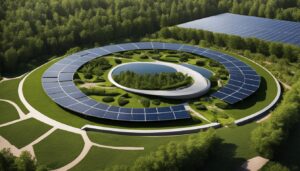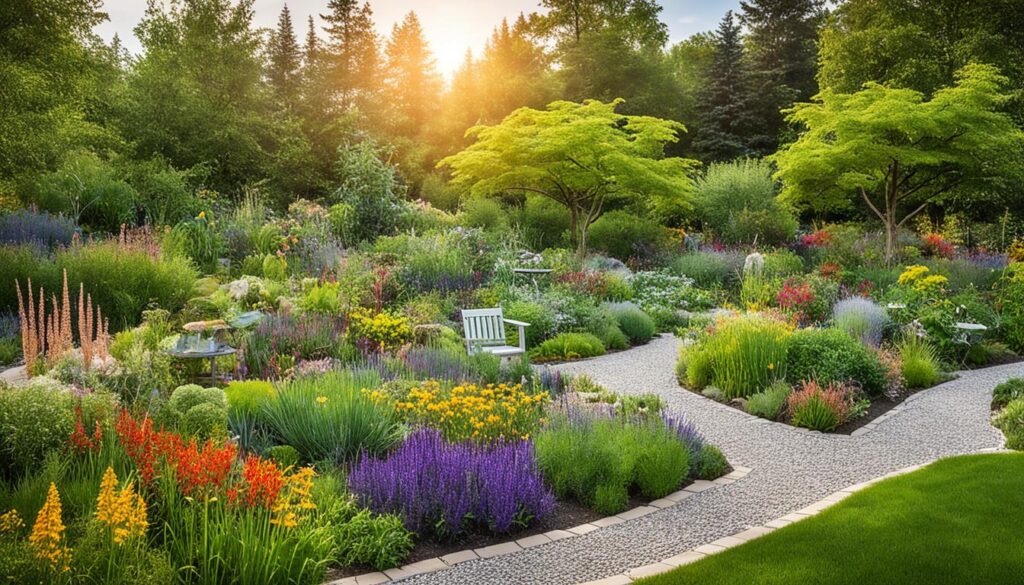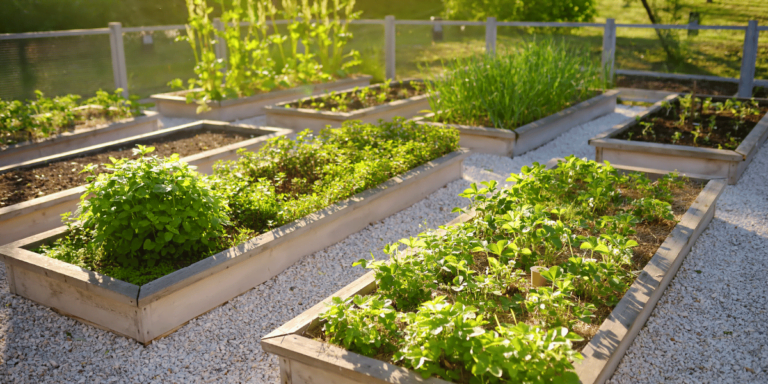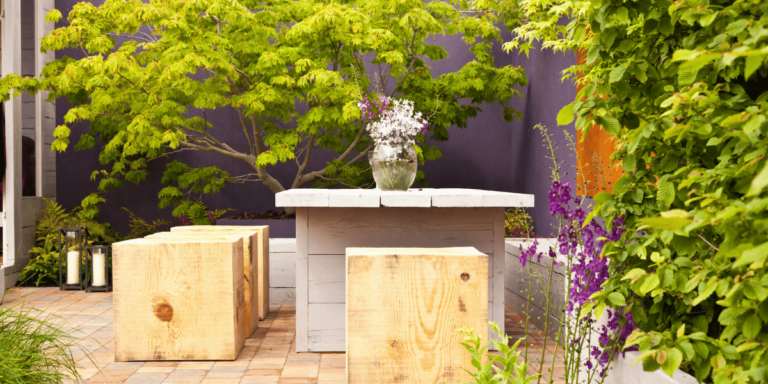The need for renewable energy solutions has become more pressing today than ever. As the effects of climate change become increasingly apparent, individuals and organizations alike are looking for ways to reduce their carbon footprint and contribute to a more sustainable future. One such solution is the integration of solar panels into our landscapes. Solar panels harness the power of the sun to provide clean energy and can be seamlessly incorporated into the aesthetic design of our outdoor spaces. They offer a renewable energy solution that reduces reliance on fossil fuels and lowers utility bills.
Key Takeaways:
- Solar panels in garden shed designs offer a renewable energy solution that reduces reliance on fossil fuels.
- Integrating solar panels into landscapes can lower utility bills and contribute to a more sustainable future.
- Solar panels can be seamlessly incorporated into the aesthetic design of outdoor spaces.
- By harnessing the power of the sun, solar panels provide clean energy and reduce carbon footprint.
- Incorporating solar panels into garden design enhances the beauty and functionality of outdoor spaces.
Transforming Your Landscape with Thoughtful Solar Panel Integration
Integrating solar panels into your landscape allows you to tap into the abundant energy provided by the sun while reducing your carbon footprint and saving on energy costs. Solar panels convert sunlight into electricity, providing a reliable and sustainable power source for various applications.
Advancements in solar panel design now make it possible to seamlessly integrate them into landscapes without compromising their visual appeal. By carefully planning the placement and design of solar panels, you can create a harmonious balance between technology and nature.
Additionally, incorporating solar panels into your landscape can enhance your outdoor living experience with solar-powered lighting, water features, and charging stations for electric vehicles.
Imagine enjoying a beautifully designed garden while also taking advantage of green energy. With innovative water conservation techniques, you can create an environmentally friendly oasis that combines aesthetics with sustainability.
Green Energy Meets Aesthetics
When it comes to integrating renewable energy in gardens, the aesthetic aspect plays a crucial role. Many homeowners worry that solar panels will disrupt the visual harmony of their landscape. However, with advancements in solar panel design, these concerns can be put to rest.
Solar panels now come in various sizes, shapes, and colors, allowing seamless blending with different garden designs and themes. From discreetly placing solar panels on rooftops or carports to using them as shade structures or even incorporating them into garden sculptures, the possibilities are endless.
By selecting solar panels that complement the style and color palette of your garden, you can create a cohesive and visually striking outdoor space.
Innovative Water Conservation Techniques
Green energy in gardens goes hand in hand with innovative water conservation techniques. By combining solar panels with smart irrigation systems and rainwater harvesting, you can minimize water wastage while maintaining a vibrant and healthy garden.
Smart irrigation systems can automatically adjust watering schedules based on weather conditions, soil moisture levels, and plant requirements, ensuring efficient water usage. Rainwater harvesting systems can collect and store rainwater to be used for irrigation purposes, reducing the reliance on municipal water sources.
With solar-powered pumps, you can even power your water features, such as fountains or ponds, without the need for grid electricity. This not only saves energy but also adds a touch of tranquility and beauty to your garden.
To illustrate the impact of solar panel integration on water conservation, we can compare the water consumption of traditional electrical-powered garden features versus their solar-powered counterparts:
| Garden Feature | Traditional Electrical-Powered | Solar-Powered |
|---|---|---|
| Water Fountain (daily) | 15 liters | 0 liters |
| Pond Pump (monthly) | 200 gallons | 0 gallons |
| Outdoor Lighting (nightly) | 4 kWh | 0 kWh |
As we can see from the table above, solar-powered garden features have zero water consumption and significantly reduce energy usage compared to their traditional electrical-powered counterparts. This demonstrates how integrating solar panels in your landscape can contribute to water conservation and overall sustainability.
Next, we’ll explore how gardens can become energy-efficient while creating a sanctuary for native plants and wildlife in Section 3.
Harnessing the Power of Nature: Creating an Energy-Efficient Garden Sanctuary
Sustainable landscaping techniques can transform your garden into an energy-efficient oasis. By reducing water consumption, minimizing pesticide use, and creating habitats for native plants and wildlife, you can promote biodiversity and reduce your environmental impact. Efficient water management, native plant selection, composting, and incorporating renewable energy sources like solar panels are key techniques to consider. By embracing these practices, you can create an environmentally conscious outdoor space that enhances your well-being and contributes to a greener future.
Reducing Water Consumption
Water is a precious resource, and practicing efficient water management techniques in your garden can help conserve it. Consider implementing the following:
- Install a drip irrigation system that delivers water directly to plant roots, minimizing evaporation and water waste.
- Collect and reuse rainwater in a rain barrel or cistern to water your plants.
- Group plants with similar water needs together to avoid overwatering.
Minimizing Pesticide Use
Pesticides can harm beneficial insects and pollute the environment. Adopting natural pest control methods can help protect your garden while preserving wildlife. Here are a few eco-friendly alternatives:
- Encourage beneficial insects like ladybugs and lacewings, which feed on garden pests, by planting flowers they love.
- Use organic insecticidal soaps or neem oil to control pests without harming beneficial creatures.
- Practice crop rotation and companion planting to naturally deter pests and reduce the need for chemical pesticides.
Creating Habitats for Wildlife
Attracting native plants and wildlife to your garden creates a thriving ecosystem and promotes biodiversity. Consider the following tips:
- Select native plants that provide food, shelter, and nesting sites for local wildlife.
- Include features like bird feeders, birdbaths, and nesting boxes to attract birds to your garden.
- Add a water source, such as a small pond or shallow dish, to provide drinking and bathing opportunities for wildlife.
Incorporating Renewable Energy Sources
Harnessing solar power through the installation of solar panels can further enhance the energy efficiency of your garden. Solar panels are a clean and renewable source of energy that can power various garden features. Consider the following possibilities:
- Use solar-powered lighting to illuminate pathways and highlight garden focal points.
- Install a solar-powered water feature to add a tranquil element to your garden.
- Set up a solar-powered charging station for your gardening tools or outdoor electronics.
By embracing these sustainable landscaping techniques and incorporating renewable energy sources, you can create an energy-efficient garden sanctuary that not only benefits the environment but also provides a peaceful and beautiful retreat for you and wildlife.
Revamp Your garden shed designs with Solar-Powered Elegance
Incorporating solar panels into your garden design can add elegance and functionality to your outdoor space. By harnessing the power of the sun, you can transform your garden into a sustainable paradise that showcases your commitment to renewable energy and environmental consciousness.
Solar-Powered Accent Lighting
Enhance the ambiance of your garden with solar-powered accent lighting. These energy-efficient lights can be strategically placed to highlight architectural features, pathways, or specific plants, creating a captivating and inviting atmosphere. With solar-powered accent lighting, you can enjoy the beauty of your garden even after the sun sets.
Solar-Powered Water Features
Create soothing focal points in your garden with solar-powered water features, such as fountains and ponds. These eco-friendly additions not only add visual appeal but also provide a tranquil and relaxing environment. Powered by the sun, these water features eliminate the need for electricity and reduce your carbon footprint.
Solar-Powered Garden Accessories
Add charm and sustainability to your garden with solar-powered accessories. From bird feeders that attract wildlife to decorative lanterns that illuminate your outdoor space, these accessories combine functionality with environmental consciousness. By harnessing the power of the sun, you can showcase your dedication to renewable energy in every corner of your garden.
Solar-Powered Charging Stations
Keep your devices powered up while enjoying your garden with solar-powered charging stations. These innovative solutions provide a convenient and eco-friendly way to charge your smartphones, tablets, and other electronic devices. By utilizing solar energy, you can reduce your reliance on traditional electrical outlets and contribute to a greener future.
By incorporating solar-powered elegance into your garden design, you can create a sustainable and visually stunning outdoor space. From accent lighting to water features and garden accessories, solar energy can revolutionize the way you enjoy and enhance your garden.
Going Solar With Your Home Garden
Investing in solar panels is an excellent way to harness the sun’s power and bring renewable energy to your home garden. By going solar, you can enjoy the benefits of sustainable energy while reducing your carbon footprint and saving on energy costs. Solar panels provide a free and abundant source of power, allowing you to power various aspects of your garden using clean, renewable energy.
When it comes to solar panels, there are two main types to choose from: monocrystalline and polycrystalline. Monocrystalline panels offer higher efficiency but come at a higher cost, while polycrystalline panels are more budget-friendly. Both options provide an eco-friendly solution for powering your garden.
With solar panels in place, you can power a range of garden features and systems, including:
- Outdoor lighting: Illuminate your garden using solar-powered lights, which soak up sunlight during the day to provide beautiful, sustainable lighting at night.
- Irrigation timers: Ensure that your plants receive the right amount of water while conserving resources by using solar-powered irrigation timers.
- Garden tools: Power your electric garden tools, such as lawnmowers, trimmers, and leaf blowers, using solar energy.
- Fountain pumps: Create a tranquil atmosphere in your garden with a solar-powered fountain. The sun’s energy will keep the water flowing and add a soothing touch to your outdoor space.
By incorporating solar panels into your home garden, you can enjoy these benefits:
- Energy cost savings: Solar panels reduce reliance on traditional energy sources, lowering your electricity bills and providing long-term financial savings.
- Environmental sustainability: By generating clean, renewable energy, you contribute to a greener future and help combat climate change.
- Eco-friendly gardening: Powering your garden with solar energy aligns with organic gardening practices and promotes overall sustainability.
- Independence from the grid: With solar panels, you become less dependent on the grid, giving you more control over your energy supply.
Indoor Hydroponic Systems
In addition to utilizing solar energy in your outdoor garden, you can also explore indoor hydroponic systems. These systems allow you to grow plants in a controlled environment without soil, using water enriched with nutrients. Indoor hydroponics offer several advantages, including:
- Year-round gardening: Indoor hydroponic systems enable you to grow plants regardless of the season or climate conditions, ensuring a continuous supply of fresh herbs, vegetables, and fruits.
- Water conservation: Hydroponics uses significantly less water compared to traditional soil-based gardening, making it a more sustainable choice.
- Space efficiency: Vertical hydroponic systems maximize space utilization, making them ideal for small gardens or urban environments where space is limited.
- Pest control: Since hydroponics doesn’t involve soil, it reduces the risk of pests and diseases commonly found in traditional gardening.
Embracing indoor hydroponics along with solar energy allows you to create a self-sustaining and eco-friendly garden ecosystem.
Organic Composting Methods
Composting is an essential practice for any eco-conscious gardener. By transforming kitchen scraps and yard waste into nutrient-rich compost, you can enrich the soil and improve plant health. Here are some organic composting methods to consider:
- Backyard composting: Use a compost bin or designated area in your garden to decompose organic matter. Allow organic materials, such as fruit and vegetable peels, coffee grounds, and yard trimmings, to break down naturally, creating nutrient-rich compost.
- Vermicomposting: Set up a worm composting system using redworms, such as Eisenia fetida. These worms consume organic waste and produce nutrient-rich castings, known as vermicompost, which can be used to nourish your plants.
- Bokashi composting: Bokashi composting uses a special mix of microorganisms to ferment organic waste quickly. This anaerobic process eliminates odors and allows you to compost a wider range of materials, including meat, dairy, and cooked foods.
- Green manure cover cropping: Plant cover crops, such as legumes or grasses, in your garden during fallow periods. These crops help suppress weeds, prevent soil erosion, and add organic matter when turned under the soil.
By implementing these organic composting methods, you can reduce waste, improve soil fertility, and cultivate a thriving and sustainable garden.
Sustainable Landscaping: Transforming Your Garden into an Energy-Efficient Oasis
Sustainable landscaping is an innovative approach to garden design that focuses on minimizing environmental impact while maximizing the beauty and functionality of outdoor spaces. By adopting sustainable practices, homeowners can create a garden that not only reduces water consumption and pesticide use but also contributes to renewable energy generation, such as green roof ecosystems and contemporary garden artistry.
Native Plant Selection:
One important aspect of sustainable landscaping is selecting native plants for your garden. Native plants are well-adapted to the local climate and require less water, fertilizer, and maintenance. They also provide food and shelter for native wildlife, adding biodiversity to your garden ecosystem.
Efficient Irrigation Systems:
Efficient irrigation systems play a crucial role in sustainable landscaping. Drip irrigation and smart sprinkler systems deliver water directly to the plants’ roots, minimizing water waste through evaporation and runoff. Installing rainwater harvesting systems can also collect and store rainwater for later use, reducing reliance on municipal water sources.
Composting:
Composting is a sustainable gardening technique that recycles kitchen scraps and yard waste into nutrient-rich soil amendments. By composting organic matter, you can improve soil quality, reduce the need for synthetic fertilizers, and divert waste from landfills.
Renewable Energy Integration:
Integrating renewable energy sources, such as solar panels or solar-powered garden lights, into your garden design can further enhance sustainability. Solar panels provide clean and renewable energy to power outdoor features, reducing reliance on fossil fuels and lowering energy costs.
Transform your garden into an energy-efficient oasis by embracing sustainable landscaping practices. By carefully selecting native plants, implementing efficient irrigation systems, composting organic waste, and integrating renewable energy technologies, you can create a beautiful and eco-friendly outdoor space.
| Benefits of Sustainable Landscaping | Green Roof Ecosystems | Contemporary Garden Artistry |
|---|---|---|
| Reduces water consumption | Provides insulation | Creates unique and artistic designs |
| Minimizes pesticide use | Improves air quality | Enhances visual appeal |
| Promotes biodiversity | Reduces urban heat island effect | Integrates architecture and nature |
| Supports native wildlife | Offers stormwater management | Provides functional outdoor spaces |
Enhancing Energy Efficiency through Smart Landscaping
Smart landscaping techniques can further enhance energy efficiency in your garden. By incorporating biophilic design principles, you can create a connection between nature and your outdoor space. Planting trees strategically to provide shade during hot summers and act as windbreaks during winter can naturally regulate temperature and reduce the need for artificial cooling and heating. Smart automation systems can optimize water usage, irrigation schedules, and outdoor lighting, ensuring efficient resource management. By embracing these smart landscaping practices, you can create an energy-efficient garden that promotes sustainability and harmony with nature.
Embracing Biophilic Design
- Integrate natural elements such as plants, water features, and natural materials into your garden design
- Create a habitat for wildlife by incorporating bird feeders, butterfly gardens, and bat boxes
- Design outdoor spaces that evoke a sense of tranquility and well-being
Smart Garden Automation
- Install smart irrigation systems that adjust watering schedules based on weather conditions
- Utilize sensor-based technology to track soil moisture levels and only irrigate when necessary
- Implement outdoor lighting systems with motion sensors or timers for energy-efficient illumination
By embracing biophilic design principles and incorporating smart garden automation, you can make your garden more sustainable and energy-efficient. These techniques not only reduce your environmental impact but also create a beautiful and harmonious outdoor space that fosters a deep connection with nature and promotes overall well-being.
Conclusion
The integration of renewable energy solutions, such as solar panels, into garden design offers numerous benefits. By harnessing the power of the sun, you can reduce your carbon footprint, lower energy costs, and enhance the beauty and functionality of your outdoor space. With the increasing importance of eco-friendly practices, creating a garden that embraces renewable energy is a smart and sustainable choice.
Sustainable landscaping techniques play a crucial role in achieving an eco-friendly garden renovation. By carefully selecting native plants, implementing efficient water management systems, composting organic waste, and incorporating smart design principles, you can further maximize energy efficiency and contribute to environmental sustainability. These practices not only reduce your impact on the planet but also create a vibrant and thriving garden ecosystem.
Transforming your garden into a renewable energy-powered oasis showcases your commitment to a greener future. By embracing renewable energy solutions and sustainable landscaping techniques, you’re not only benefiting yourself but also inspiring others to follow suit. Take the first step towards an eco-friendly garden renovation and embrace the power of renewable energy in your outdoor space today.
Frequently Asked Questions
How can I incorporate renewable energy into my garden design?
One way to incorporate renewable energy into your garden design is by harnessing the power of the sun with solar panels. Solar panels convert sunlight into electricity, providing a reliable and sustainable power source for various applications in your garden.
What are the benefits of integrating solar panels into my landscape?
Integrating solar panels into your landscape allows you to tap into the abundant energy provided by the sun while reducing your carbon footprint and saving on energy costs. Solar panels provide clean energy and can be seamlessly incorporated into the aesthetic design of your outdoor spaces.
How can I create an energy-efficient garden sanctuary?
To create an energy-efficient garden sanctuary, you can adopt sustainable landscaping techniques such as reducing water consumption, minimizing pesticide use, and creating habitats for native plants and wildlife. Efficient water management, native plant selection, composting, and renewable energy integration are key techniques to consider.
How can I revamp my garden with solar-powered elegance?
To revamp your garden with solar-powered elegance, you can incorporate solar-powered accent lighting to transform the ambiance, solar-powered water features like fountains and ponds for soothing focal points, and solar-powered garden accessories like bird feeders and decorative lanterns that enhance the visual appeal.
How can I go solar with my home garden?
Going solar in your home garden is a practical and sustainable choice. By investing in solar panels, you can harness the power of the sun to provide free energy for your garden. Solar panels can power outdoor lighting, irrigation timers, garden tools, and even fountain pumps.
How can I transform my garden into an energy-efficient oasis?
To transform your garden into an energy-efficient oasis, you can embrace sustainable landscaping techniques such as efficient water management, composting, and incorporating renewable energy sources like solar panels. Green roof ecosystems and contemporary garden artistry can also contribute to energy efficiency and environmental sustainability.
How can I enhance energy efficiency in my garden with smart landscaping techniques?
By incorporating biophilic design principles, planting trees strategically for shade and windbreaks, and using smart automation systems for water usage, irrigation schedules, and outdoor lighting, you can enhance energy efficiency in your garden. Smart landscaping practices promote sustainability and harmony with nature.
What are the key benefits of renewable energy integration in gardens?
By integrating renewable energy solutions like solar panels into garden design, you can reduce your carbon footprint, lower energy costs, and enhance the beauty and functionality of your outdoor space. Sustainable landscaping techniques further contribute to energy efficiency and environmental sustainability.













